Thursday, February 22, 2007
Body art
Over the course of the last 50 years, artists have investigated the aesthetic frontiers of the body. A central notion of human identity, the idea of the physical body and the human self -as stable - has eroded (think of two world wars, the Holocaust, Viet-Nam, AIDS, plus the redefinition of the body in light of the developments in psychoanalysis, philosophy, anthropology, medicine, etc). Artists have investigated the temporality, contingency and instability of the body within and beyond cultural boundaries. One can generally define several areas of investigation: 1- The gesturing body, or the performing body: A dual role of object and subject that becomes public and gets transformed by activism (here we have the FLUXUS performances of Ono, Klein, Beuys, Nauman, etc). 2- The ritualistic body, as one finds in the Viennese Actionists' use of the symbolic language of torture, slaughter and sacrifice (among them Günter Brus, Hermann Nitsch and Otto Mühl, as a way to deal with the horrors of post-War Nazi Austria). Or the self-mutilated body of Gina Pane and Mike Parr and the dying body -as bravely documented by Hannah Wilke. Also the desecrating body (as in Serrano’s Piss Christ). 3- The body as "participatory," as in Chris Burden's symbolic antics, Carolee Schneemann performances and Yayoi Kusama's staged "orgies." 4- The body as identity; whether expanding the idea of gender (the transgender phenomenon), sexuality or race, identity is characterized as a cipher in constant evolution (through the use of props, masks, costumes or any other disguises). In this category, we have the works of Pierre Moliniere, Lynda Benglis, Laura Aguilar, Paul McCarthy and others. 5- The idea of body as boundary: The artist's body is the limit between the private and the public realms and what is inflicted upon that body is inflicted somehow in the social or collective body. These artists examine issues of power, control and intimacy regarding liberties we can and cannot take within our own bodies. In this category we have the works of Dennis Oppenheim, Vito Acconci, Gina Pane, William Wegmann and Marina Abramovic -among others. To better understand the context of body art, take a look at these interesting topics: tatooing, body piercing, corseting, scarification, infibulation, self-flagellation.
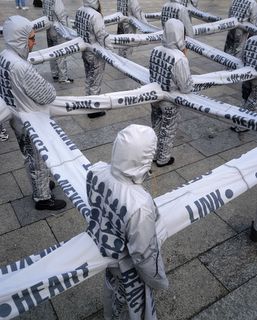
Lucy Orta's Nexus Architecture x 50 Intervention (2001). Orta creeates interventions in social groups and activities through protective clothing worn, designed and even created by marginalized people in the streets.

Eglė Rakauskaitė's IN FAT (1998). The Lithuanian artist focuses on naked an vulnerable aspects of the body and its means for self-protection.
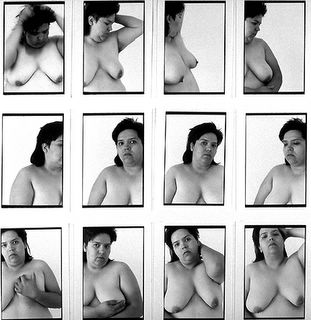
Laura Aguilar's Self-Portrait (1995). Aguilar uses black and white photography to authenticate her body/self identity as an overweight "Latina Lesbian." Her work generally focuses on physical pain her learning disability and the particularities of her organic body.

Gilbert & George's The Singing Scripture (1978). G&G first performed as human sculptures at several London art schools and two open-air rock concerts inthe late 1960's. In buttoned-up suits, with short hair and faces painted in metallic silver and gold, they struck robotic pose (mimicking the words of Edwardian music hall songs).

Pierre Molinier's The Spurr of Love (1966-68). Molinier depics himself as a hermaphrodite, a state of sacred perfection "transfixed for consumption by his own voyeuristic eyes."

Ana Mendieta's Silueta Series ( late 1970's). Mendieta's earth actions are metaphors for the stages of death and dissolution: "I have been carrying out a dialogue between the landscape and the female body (based on my own silhouette)."

Lynda Benglis (Untitled, 1974). The body as gender: Posing like a man in her car, or in a pin-up-style submissive role. Untitled was featured in Artforum and intended as a centerfold artist's statement.


Through the 1970's New York artist Hannah Wilke made a series of performalist self-portraits (entitled S.O.S) with her body being tainted by some disease. As it turns, Wilke was later diagnosed with lymphoma. She documented her ordeal of physical decline until the very end when she was no longer young and beautiful.

Orlan's Omnipresence (1993). Orlan's seventh "performance operation" was broadcast via live satellite from the Sandra Gering Gallery in New York to fifteen sites worldwide, including the Centre Pompidou, Paris, the McLuhan center, Toronto and the Multi-Media Center, Baniff. Spectators around the world could ask the artist questions before and after the intervention. The operation was performed by a feminist plastic surgeon, Dr. Marjorie Cramer, who inserted implants above Orlan's eyes and in her cheeks and chin. Orlan's "new face" was intended to idealized a different idea of physical female beauty.
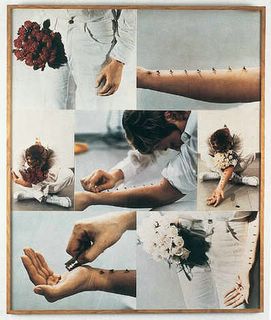
Gina Pane's Sentimental Action (1973). "This aggressive ambiguity towards the body – whether practised by Stuart Brisley or Marilyn Manson – has always pulled in two opposite directions, both towards and away from Western civilisation. Tribal cultures have often adopted painful initiation rites. The film A Man Called Horse (1970) shows Richard Harris suspended by hooks pierced through his chest muscles in a scene that could have been directed by Fluxus artists, but is said to be a rigorously authentic depiction of the rites of Native Americans. The tattoo parlours of the East Village conjure up a myth of man’s tribal nature through Maori and Celtic-inspired designs, breaking with the idea of the city as a civilised, stable regime (tattoo parlours within New York were illegal until very recently and at least one of the city’s dominant religions, Judaism, expressly forbids tattooing). The practitioners call it body art, and it proclaims that the city is chaotic and tribal: a jungle, I suppose. Yet at the same time a part of me recognises that there are no initiation rites; no one is compelling today’s youth to attack or adorn their bodies. More than an expression of tribal identity, body art is another way to assert a Western identity: a love of liberty and individuality. And the method of asserting this identity is also very Western: drawing attention to the weak and mortal body in order to proclaim the nobility of the mind or the soul."--Nicholas Blincoe

Joseph Beuys's I Like America and america Likes Me (1974). For the opening of the Rene Block Gallery in New York, Beuys lived in the space together with a wild coyote named Little Joe for five days. Wrapped in felt on his arrival at JFK Airport and driven to the gallery by ambulance, Beuys entered the hay-strewn space holding a sheperd's staff. At the end of the five days, he returned to the airport as he had come.

Charles Ray's Plank Piece (1973). This work was an investigation of the plane that simultaneously divides and supports the body. Ray inserted his body into a simple equation of support, aligning the joints separating his pelvis from his torso and his calves from his thighs with the angle of connection between the wall and a plank laid against it.

Günter Brus' Selfpain, Selfmutilation (1965). The central role Brus played in Vienna Actionism (1964-1970) is manifested in the radicalness with which he used his own body as a medium for his performances. As a consequence of these "actions" the artist had to leave Austria. This ended one day in a dance excess that I celebrated on a marble-topped cafe table. As I was about to herald the grand finale with a few hefty stomps, the marble top shattered...it was at the very least the chain of association — marble plate-marble cake-mummy cake-tummy cooking = shit — that made me drop my trousers and force out my bladder and belly refuse.-- GB
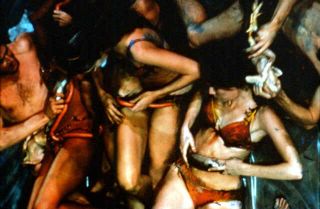
Carolee Schneemann's Meat Joy (1964): "Meat Joy has the character of an erotic rite: excessive, indulgent, a celebration of flesh as material: raw fish, chickens, sausages, wet paint, transparent plastic, rope brushes, paper scrap. Its propulsion is toward the ecstatic -shifting and turning between tenderness, wilderness, precision, abandon: qualities which could at any moment be sensual, comic, joyous, repellent."-- Carolee Schneemann
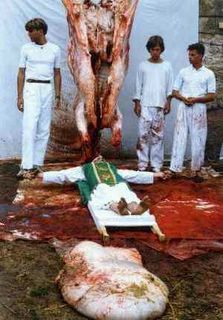
Hermann Nitsch's Orgiastic Performances (late 1960's). Nitsch's orgiastic performances, what he called 'total work of art' or Gesamtkunstwerk, looked a bit like Alan Kaprow's more secular happenings (in New York in the early 1960's). According to Nitsch, "In the fifties the most diverse artists from all over the world were confronted with the insufficiency of their respective media. They proceeded to ‘Aktionen’ and happenings with real events, that may be tasted, smelt, seen, heard and touched. This was the breakthrough to reality." Nitsch's endeavour to initiate this ritual of rituals must be seen against the broader background of the idea that art is the successor of religion. To phrase it in his own words: "To me, art is a kind of priesthood, since traditional religions have lost their spell." In a manifesto he says of the existential-sacral painting: "We strive for a consequent sacralisation of art and for a thorough spiritualization of existence whereby man becomes the priest of Being." In the end, the reality was slightly different; a handful of actors performing the 'orgiastic ecstasy,' gaped at by a handful of passive spectators, drinking, discussing, laughing and smoking…
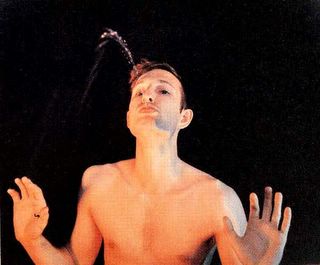
Bruce Nauman's Self Portrait as a Fountain (1966-67). Naumen made a series of photographs during a period of self-absorption in his studio. Posing as a self-generating fountain, an art object ejecting water into the air in a controlled stream from his pursued lips, Nauman parodied the traditionof public sculptors who represent the heroic male in poses validating his masculinity.

William Wegman's Family Combination (1972). "Family Combinations is a set of six photographs in two groupings. The first grouping is a series of portraits of the artist, his mother, and father. Framed in an identical manner, each member of the family stands in front of a white background and wears a plain dark shirt. Scientific in their approach, the photographs capture Wegman and his parents staring blankly past the camera. An analytic record of physical features, Wegman treats each face with a cool detachment. Taking his analysis to the next extreme, the artist combines the first set of images to produce the second, overlapping mother with son and father with mother. From left to right, father Wegman's nose bursts out of his son’s face, mother Wegman's hair sits atop the artist's head, and mother and father combined produce a head which looks nothing like their son. The father/mother combination is the last photograph of the six and is situated diagonally across from the straightforward portrait of Wegman that - if we are to read the series from left to right - is our starting point in the work. The disjunction between beginning and end, not to mention between an emotionally dry approach to photography and portraits of one's own family, are humorous paths into the work. With a deadpan expression similar to the 1920s film comedian Buster Keaton, Wegman's unsmiling face masks a whimsical fascination with his own identity and with the medium of photography."-- Taken from a PBS essay on Wegmann's Family Combination.

Yasumasa Morimura's Self-Portrait After Marilyn Monroe (1996). Morimura burst onto the international art scene about 10 years ago with his "Art History" series, computer-aided reconstructions of great Western paintings that featured the artist’s big-nosed face replacing the faces of the works’ original subjects. The high-tech Japanese kitsch was embraced by a Western world passing through a period of growing interest in sushi, economic miracles, and things Japanese in general, and Morimura became somewhat of a superstar both at home and abroad. His more recent work has featured the artist made-up as Hollywood starlets, and has won the Osaka-based artist solo shows at the Museum of Contemporary Art, Chicago, the Yokohama Museum of Art, and ensured his inclusion in major group shows at scores of important galleries and museums around the world.
Subscribe to:
Comments (Atom)
